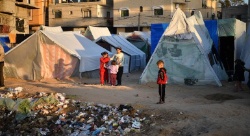Cablegate: Romania: Opic Finance and Renewable Energy Investment
VZCZCXYZ3883
PP RUEHWEB
DE RUEHBM #0674 2790923
ZNR UUUUU ZZH
P 060923Z OCT 09
FM AMEMBASSY BUCHAREST
TO RUEHC/SECSTATE WASHDC PRIORITY 9945
RUEHZL/EUROPEAN POLITICAL COLLECTIVE PRIORITY
UNCLAS BUCHAREST 000674
STATE FOR EUR/CE ASCHEIBE
STATE PLEASE PASS TO OPIC BBRERETON
SIPDIS
E.O. 12958: N/A
TAGS: ECON ENRG EFIN EINV RO
SUBJECT: ROMANIA: OPIC FINANCE AND RENEWABLE ENERGY INVESTMENT
REF: STATE 95170
1. In response to reftel request for comments on a proposed OPIC
loan to USRG Emerging Market Fund, post believes that Romania offers
good opportunities for investment in renewable energy development.
Although Europe is not the regional focus of the proposed fund,
Romania's significant renewable energy potential, especially in wind
energy, makes it a potentially strong candidate for investment from
external sources. The global economic crisis has limited available
funding for energy projects, including from the Romanian Government.
State control of major energy producers and inadequate investment
in the state-owned electrical grid are major limiting factors.
There is a particular need for investments in modernizing Romania's
electrical grid in order to accommodate new renewable generation
capacity.
2. The availability of commercial bank credit in Romania remains
limited. However, some of the financing gap has been filled by
institutions such as the European Bank for Reconstruction and
Development (EBRD) and European Investment Bank (EIB), both of which
have an established presence in Romania and a mandate to pursue
renewable energy development. USRG may find itself competing, in
some instances, with both of these entities if it chooses to pursue
projects in Romania. EBRD recently granted a 170 million euro loan
to modernize a coal-fired power plant, while the EIB has
underwritten the construction of a new natural gas generation
facility. The EBRD has also been supportive of hydropower projects.
3. Growth in Romania's renewable energy sector is driven both by
energy security concerns and EU-imposed renewable energy targets.
Romania aims for renewable energy to account for 33 percent of total
consumption in 2010, 35 percent in 2015, and 38 percent in 2020.
Romania is largely able to meet these targets through hydropower
generation, which accounts for almost 30 percent of installed
capacity. Wind energy currently totals 13 MW, meeting 0.06 percent
of demand, while biomass meets another 0.06 percent of demand. Wind
generation should expand exponentially when CEZ completes
construction of what will become Europe's largest onshore wind farm,
a 600 MW facility in Dobrogea (southeastern Romania).
4. Romania uses a quota system with tradable green certificates
(TGC) to support renewable energy. It does not have feed-in
tariffs. TGCs are issued to electricity producers using wind,
solar, biomass, and hydropower generated in plants with less than 10
MW of capacity. They are traded on the green certificates market
and fetch up to 55 euro per certificate. Romania also has a 260
million euro state aid scheme that targets renewable energy
projects. The maximum amount per individual project under this
scheme is EUR 50 million.
5. Post has no objection to OPIC's proposed loan to USRG,
especially if funds could be used to support both infrastructure
development and new generation capacity.
GITENSTEIN


 UN News: 10,000 People Feared Buried Under The Rubble In Gaza
UN News: 10,000 People Feared Buried Under The Rubble In Gaza Save The Children: Heat-stricken Bangladesh Extends School Closures
Save The Children: Heat-stricken Bangladesh Extends School Closures Hayden Stephens and Associates: Record Class Action Settlement Gives Hope To 50,000 Australian Junior Doctors
Hayden Stephens and Associates: Record Class Action Settlement Gives Hope To 50,000 Australian Junior Doctors UN News: Healing Page By Page In Earthquake-affected Türkiye
UN News: Healing Page By Page In Earthquake-affected Türkiye Save The Children: Rate Of Attacks On Healthcare in Gaza Higher Than In Any Other Conflict Since 2018
Save The Children: Rate Of Attacks On Healthcare in Gaza Higher Than In Any Other Conflict Since 2018 UN News: Green Light For New Cholera Vaccine, Ukraine Attacks Condemned, Action Against Racism
UN News: Green Light For New Cholera Vaccine, Ukraine Attacks Condemned, Action Against Racism